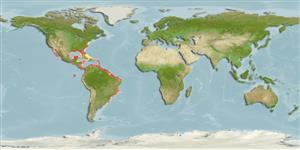Common names from other countries
Environment: milieu / climate zone / depth range / distribution range
Ecology
Marine; brackish; demersal; oceanodromous (Ref. 51243); depth range 0 - 100 m (Ref. 115829), usually 0 - 30 m (Ref. 5217). Subtropical; 11°C - 31°C (Ref. 47167); 40°N - 34°S, 117°W - 34°W
Eastern Central Pacific: Baja California to Peru (Ref. 9330); Northwestern Central Atlantic: Canada (Ref. 5951) to Chesapeake Bay, USA to the Antilles and southern Brazil.
Length at first maturity / Size / Weight / Age
Maturity: Lm 8.5, range 8 - ? cm
Max length : 21.3 cm TL male/unsexed; (Ref. 124487); common length : 15.0 cm TL male/unsexed; (Ref. 5217); max. published weight: 64.40 g (Ref. 124487); max. reported age: 1.21 years (Ref. 47359)
Inhabits sandy and muddy bottoms (Ref. 9330). Common in estuaries (Ref. 9330). Feeds on big, benthic invertebrates and small fishes (Ref. 9330). Utilized fresh (Ref. 9330).
Life cycle and mating behavior
Maturity | Reproduction | Spawning | Eggs | Fecundity | Larvae
Oviparous (Ref. 101737). Distinct pairing (Ref. 205). Females produce numerous eggs in multiple spawnings during a prolonged spawning period (Ref. 101737).
Figueiredo, J.L. and N.A. Menezes, 2000. Manual de peixes marinhos do sudeste do Brasil. VI.Teleostei (5). Museu de Zoologia, Universidade de São Paulo. Brazil. 116 p. (Ref. 36453)
IUCN Red List Status (Ref. 130435)
CITES (Ref. 128078)
Not Evaluated
Threat to humans
Harmless
Human uses
Fisheries: minor commercial
More information
ReferencesAquacultureAquaculture profileStrainsGeneticsElectrophoresesHeritabilityDiseasesProcessingMass conversion
Tools
Special reports
Download XML
Internet sources
Estimates based on models
Preferred temperature (Ref.
115969): 21.1 - 28, mean 25.7 (based on 862 cells).
Phylogenetic diversity index (Ref.
82804): PD
50 = 0.5020 [Uniqueness, from 0.5 = low to 2.0 = high].
Bayesian length-weight: a=0.00832 (0.00661 - 0.01047), b=3.10 (3.03 - 3.17), in cm Total Length, based on LWR estimates for this species (Ref.
93245).
Trophic level (Ref.
69278): 3.5 ±0.1 se; based on diet studies.
Resilience (Ref.
120179): High, minimum population doubling time less than 15 months (tmax=1.2; k >0.3).
Fishing Vulnerability (Ref.
59153): Low vulnerability (11 of 100).
